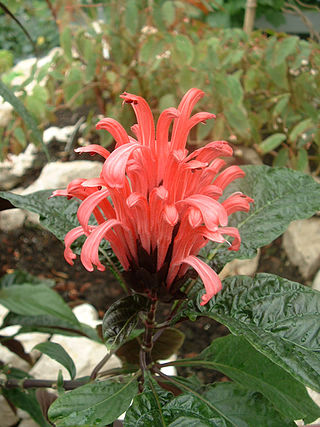
Acanthaceae is a family of dicotyledonous flowering plants containing almost 250 genera and about 2500 species. Most are tropical herbs, shrubs, or twining vines; some are epiphytes. Only a few species are distributed in temperate regions. The four main centres of distribution are Indonesia and Malaysia, Africa, Brazil, and Central America. Representatives of the family can be found in nearly every habitat, including dense or open forests, scrublands, wet fields and valleys, sea coast and marine areas, swamps, and mangrove forests.

Justicia is a genus of flowering plants in the family Acanthaceae. It is the largest genus within the family, encompassing around 700 species with hundreds more as yet unresolved. They are native to tropical to warm temperate regions of the Americas, India, and Africa. The genus serves as host to many butterfly species, such as Anartia fatima. Common names include water-willow and shrimp plant, the latter from the inflorescences, which resemble a shrimp in some species. The generic name honours Scottish horticulturist James Justice (1698–1763). They are closely related to Pachystachys.

Hypoestes is a flowering plant genus of about 150 species. They are widely distributed throughout the tropical and subtropical lands around the Indian Ocean, and some adjacent regions.
Acanthopale is a plant genus of shrubs or subshrubs in the Acanthaceae plant family. The genus name is based on the classic Greek words for thorn ákantha and stake palum. Some species in the genus are cultivated as ornamental plants.

Neuracanthus is a genus of plants in the family Acanthaceae.

Pseuderanthemum is a genus of plants in family Acanthaceae with a pantropical distribution.

Crossandra is a genus of plants in the family Acanthaceae, comprising 54 species that occur in Africa, Madagascar, Arabia and the Indian subcontinent. Some species, especially Crossandra infundibuliformis, are cultivated for their brightly colored flowers.

Phlogacanthus is a genus of flowering plants in the family Acanthaceae and tribe Andrographideae. Its distribution includes India through to Indo-China, southern China, Java, and Sulawesi.
Cyclacanthus is a genus of flowering plants in the family Acanthaceae and tribe Justicieae. The genus consists of two species endemic to Vietnam, described by Spencer Le Marchant Moore.
Stenandriopsis is a genus of flowering plants belonging to the family Acanthaceae. It includes 20 species native to tropical Africa and Madagascar. Molecular phylogenies have placed the Old World Stenandriopsis apart from New World Stenandrium, and the genus is accepted in a classification of the family Acanthaceae published in 2022.
Vindasia is a genus of flowering plants belonging to the family Acanthaceae.
Vavara is a genus of flowering plants belonging to the family Acanthaceae.
Pericalypta is a genus of flowering plants belonging to the family Acanthaceae.
Lasiocladus is a genus of flowering plants belonging to the family Acanthaceae.
Leandriella is a genus of flowering plants belonging to the family Acanthaceae.
Sphacanthus is a genus of flowering plants belonging to the family Acanthaceae.

Salpichroa is a genus of flowering plants belonging to the family Solanaceae.
Ritonia is a genus of flowering plants belonging to the family Acanthaceae.
Pseudodicliptera is a genus of flowering plants belonging to the family Acanthaceae.
Podorungia is a genus of flowering plants belonging to the family Acanthaceae.








